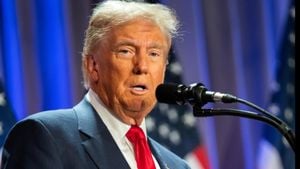The anticipation surrounding Donald Trump’s second term is palpable, as he looks to fill his administration with loyalists ready to chase the ambitious goals outlined during his campaign. Central to this vision is the controversial Project 2025, developed by the Heritage Foundation, which serves as a blueprint for sweeping changes across multiple federal agencies, including healthcare and education.
Trump’s approach this time seems more calculated, drawing on past experiences and the lessons learned during his first term. His cabinet is shaping up to include notable figures directly linked to Project 2025, indicating his intention to bring radical change to federal governance. Reports suggest names like Stephen Miller, known for his stringent immigration policies, and Dr. Mehmet Oz, poised to oversee the Centers for Medicare and Medicaid Services (CMS), among others.
Oz's nomination alone is significant, hinting at potential cuts to Medicaid and changes to Medicare, as Trump reportedly seeks to expand the role of private insurance options. Trump and his aids have hinted at wanting Trumps’ vision to potentially eliminate the Department of Education entirely, which aligns with decades of pushback from the Republican establishment aimed at dismantling federal education oversight.
While Trump appears adamant about his plans, the actual execution of these ideas may still face considerable opposition within Congress. For example, previous attempts to shut down the Department of Education were met with bipartisan backlash; a failed 2023 amendment proposed to eliminate the department garnered significant votes from Republicans who opposed the measure, highlighting political fractures within the party.
Looking back at the history of the Department of Education, its establishment was borne out of a bipartisan agreement aimed at ensuring educational equity—something many advocate for today. It’s worth noting the legacy of programs aimed at supporting low-income communities, such as Title I funding, and provisions for students with disabilities under the Individuals with Disabilities Education Act (IDEA). Trump’s proposed changes might dismantle these instruments, which many argue are foundational to the safety net of American public education.
Transitioning to healthcare, under the wings of Dr. Oz, CMS could pivot sharply away from supporting traditional Medicare toward bolstering Medicare Advantage—an increasingly popular plan backed by private insurers. Critics have raised concerns about potential cuts to Medicaid. The upcoming administration’s goals include considering imposing work requirements for eligibility and spending caps, which could shrink the program significantly and diminish access for millions.
With these proposed changes, questions loom over the future of the Affordable Care Act (ACA) as well. Trump has hinted at keeping the ACA as it is only if he can devise something markedly superior. Uncertainty about whether to renew or allow earmarked subsidies to lapse could directly impact millions of Americans who depend on the coverage and protections the ACA offers.
With the pieces of his administration slowly falling together, Trump is stacking his administration with associates from conservative think tanks who are eager to implement policies aimed at elevators American economic competitiveness, which often skews toward tax cuts favoring the wealthy.
Connecting the threads of these ambitious policy moves lays bare the ideological undercurrents driving Trump’s approach. Figures steered by Project 2025 are not only supportive of drastic changes—they’re signifying the desires of the far-right wing of the party. This could entail advanced rules against immigration, aiming to limit pathways or reinstate policies reminiscent of the harsher measures from his initial tenure.
For Trump, the election’s outcome offers him not just victory but the chance to enact deep-rooted policies favoring a hardline approach to governance. This new administration, largely filled with loyalists from the previous term, is indicative of Trump's determination to reflect his base's interests and increasingly conservative policies.
Yet, it’s the tension between Trump’s ambitious proposals, the need for congressional approval and bipartisan cooperation, and the stark realities on the ground, particularly concerning education and healthcare, where his administration's roadmap might hit hurdles. It remains to be seen if Trump's plans will manifest as intended or if the political machine will blunt the edges of these aspirations. Either way, the next few years promise to be as tumultuous as they are pivotal for American governance.



